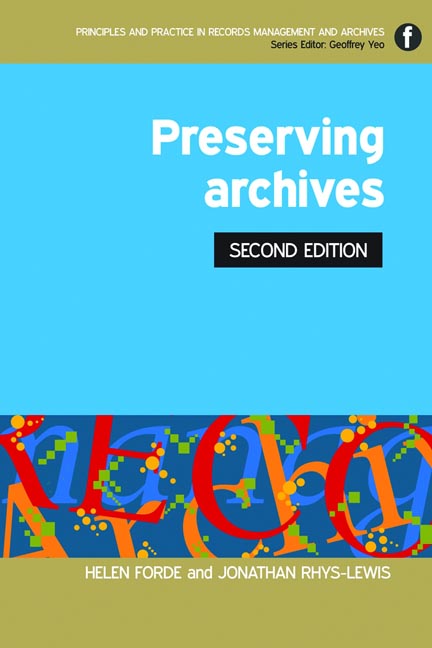Book contents
- Frontmatter
- Contents
- Introduction to the series Geoffrey Yeo
- Preface to the Second Edition
- Acknowledgements
- 1 Introducing archive preservation
- 2 Understanding archival materials and their characteristics
- 3 Managing digital preservation
- 4 Archive buildings and their characteristics
- 5 Safeguarding the building and its contents
- 6 Managing archival storage
- 7 Managing risks and avoiding disaster
- 8 Creating and using surrogates
- 9 Moving the records
- 10 Exhibiting archives
- 11 Handling the records
- 12 Managing a pest control programme
- 13 Training and the use of volunteers
- 14 Putting preservation into practice
- Appendices
- Bibliography
- British and international standards relating to archive preservation
- Index
14 - Putting preservation into practice
Published online by Cambridge University Press: 09 June 2018
- Frontmatter
- Contents
- Introduction to the series Geoffrey Yeo
- Preface to the Second Edition
- Acknowledgements
- 1 Introducing archive preservation
- 2 Understanding archival materials and their characteristics
- 3 Managing digital preservation
- 4 Archive buildings and their characteristics
- 5 Safeguarding the building and its contents
- 6 Managing archival storage
- 7 Managing risks and avoiding disaster
- 8 Creating and using surrogates
- 9 Moving the records
- 10 Exhibiting archives
- 11 Handling the records
- 12 Managing a pest control programme
- 13 Training and the use of volunteers
- 14 Putting preservation into practice
- Appendices
- Bibliography
- British and international standards relating to archive preservation
- Index
Summary
Introduction
The previous chapters have covered many of the issues encountered by archives when trying to preserve their holdings, often against a background of increasingly tight budgets and the inexorable rise in expectations of public services. Those who oversee preservation programmes have to ensure that all the relevant issues over enhanced access are discussed, that the needs of the documents, in whatever format, are considered and costed and that the effect of improving services does not shackle future generations with mounting preservation or storage costs. They have to present well argued choices for preservation strategies, and they have to manage preservation in an environment which may be financially stringent, politically pressured or is developing strategically in other directions. How can it be done? This chapter covers
• choices and weighing up the options
• responsibilities
• policies and strategies
• benchmarking and preservation assessment
• costs and funding
• planning a programme over time.
Choices and options
Choosing the right preservation tactics at the right time does much to ensure success. Fortunately several options are available and no archive has to undertake all of them all the time. The choice may appear bewildering to those who are desperately trying to do anything but the trick lies in a measured approach, often spread over several years, matching the activity to the resources available at any one time. The result should be that the archive has a well embedded, coherent preservation programme which recognizes and mitigates risk while allowing as much access to the holdings as possible.
Details of how to develop such a strategy follow, but it is important to review the options available in particular circumstances. These have been discussed in previous chapters and may, or should, include in some cases:
• regular building maintenance
• dry, cool storage
• adequate storage space
• a boxing programme
• good security procedures
• conservation facilities, or a budget for conservation
• digital preservation arrangements
• a disaster control programme
• an integrated pest management programme
• a surrogacy programme
• document handling training for readers and staff.
- Type
- Chapter
- Information
- Preserving Archives , pp. 211 - 224Publisher: FacetPrint publication year: 2013

